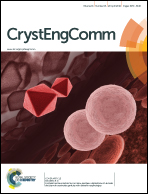Surface decoration of WO3 architectures with Fe2O3 nanoparticles for visible-light-driven photocatalysis
Abstract
Zero-dimensional Fe2O3 nanoparticles were successfully decorated on three-dimensional WO3 architectures to constitute a photocatalyst of Fe2O3@WO3 heterojunction. The obtained samples were characterized in detail by X-ray diffraction, scanning electron microscopy, elemental mapping, X-ray photoelectron spectroscopy and UV-Vis absorption spectra. The results indicate that rhombohedral α-Fe2O3 nanoparticles are homogeneously decorated on the surface of monoclinic WO3 architectures, and the constituted n+–n heterojunction results in “redshift” of the optical absorption. The photocatalyst of 1%Fe2O3@WO3 annealed at 400 °C exhibits the highest photocatalytic activity for degradation of Rhodamine B under visible light irradiation. The degradation obeys first-order reaction kinetics with an apparent rate constant of 0.057 min−1. It is suggested that the potential-energy difference between Fe2O3 and WO3 accelerates the separation of photogenerated electron–hole pairs, dominating the enhanced photocatalytic activity. The results presented herein provide new insight for development of a novel visible-light-driven photocatalyst and its potential application in harmful pollutant degradation.


 Please wait while we load your content...
Please wait while we load your content...